Llanfaredd is a village situated about two miles east of Builth Wells, in the county of Radnorshire. Within the village is St. Mary’s Parish Church and the Church contains two identically named war memorials to its parishioners who fell during both the Great War. The original memorial is made of wood and was dedicated on 30 May 1920, whilst the memorial inside the Church is of brass.
The Great War, 1914-1918
Rupert Charles Inglis, Lieutenant, South Wales Borderers. Rupert was born in Ceylon on 3 February 1884, the son of Charles George Inglis and Edith Caroline Inglis (nee Buckworth), of Glanwye, Builth Wells. His grandfather, Major Sir John Inglis, had been the commander of Lucknow during the famous siege in 1857, while Lord Chelmsford, of Zulu War fame, was his great-uncle. Rupert was educated at St. Andrew’s School, Eastbourne and at Uppingham before leaving for a new life in Canada. He returned to Britain after the outbreak of war and was commissioned into the South Wales Borderers in December 1914, along with his brother, Harold John Inglis. The brothers were posted to the 2nd Battalion, South Wales Borderers, which had just returned to England from service in China. The battalion joined 87 Brigade, 29th Division and in April 1915 embarked for the Mediterranean, before taking part in the Gallipoli Landings on 25 April 1915. Rupert was slightly wounded on 11 June in an engagement which saw him and his brother both recommended for the Military Cross. Rupert soon returned to duty and was wounded again whilst leading his men on an attack against the Turks on 28 June and died the following day, 29 June 1915, aged 31. He has no known grave and is commemorated on the Helles Memorial, Gallipoli. His death prevented his award of the Military Cross, as it was not a posthumous award. He is also commemorated at Builth Wells Parish Church. His brother Harold John Inglis, also served with the 2nd SWB and was awarded the Military Cross for the action, later being recommended for the VC, but being instead awarded the DSO:
‘Second-Lieutenant Harold John Inglis, 3rd Battalion, the South Wales Borderers (attached 2nd Battalion). For conspicuous gallantry on the 10th and 11th June, 1915, during operations south-west of Krithia. He and his brother (Lieut. R. C. Inglis, of the same battalion) made a gallant attempt to capture an enemy’s sap, distant about 90 yards. Crawling over the open ground with their men, they reached the sap, which was about five feet deep, increasing to seven or eight feet, down which the party had to proceed in single file. The party were checked in the deepest part of the sap by machine gun fire and bombs and had to retire. Second-Lieutenant H. J. Inglis then made a second attempt and again seized the sap-head. Advancing along the sap, he was wounded and was eventually forced to retire by very heavy rifle fire. He showed great skill and gallantry in a difficult position. Lieut. R. C. Inglis was wounded and has since died of his wounds.’
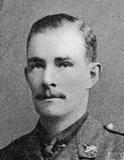
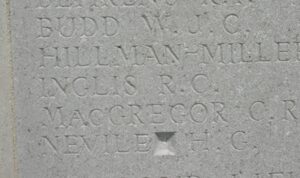
Albert Price Meredith, Private, 201754, Welsh Regiment. Albert was the son of Thomas and Eliza Ann Meredith, of Penrhulais, Llanfaredd. He worked as a waggoner before enlisting at Tonypandy into the Welsh Regiment, and was posted to the 4th Battalion, Welsh Regiment, which was attached to the 53rd (Welsh) Division. Albert joined the battalion in Egypt, following its evacuation from Gallipoli. The 53rd Division then spent a year on the Suez Canal Defences whilst forces, the EEF, were built up in preparation for an assault on Turkish held Palestine. The 53rd Division was encamped on the beach at Sheikh Zowaiid at the end of February 1917 and prior to the launching of the offensive into Palestine had moved to positions east of Deir el Belah. At dawn on 26 March 1918 the division advanced across the Wadi Ghuzee, its objective Ali Muntar, on the outskirts of Gaza. By this time the battlefield was shrouded in thick fog, so there was no air support. The division soon came under fire from the heights of Ali Muntar and the el Sire Ridge, and began taking heavy casualties. By 14.00 it had become obvious that the attack had been held. The First Battle of Gaza had ended in failure for the EEF. Albert was one of many casualties suffered during the day of the battle, 26 March 1917. He was 26 years old and is commemorated on the Jerusalem Memorial, Israel.
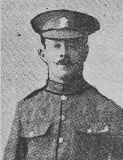
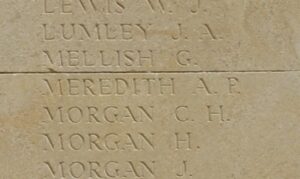
Arthur Harley, Private, 239036, Herefordshire Regiment. Arthur was the son of Pryce and Margaret Harley, of Tynlwyn, Llanfaredd. He enlisted at Glasbury into the Herefordshire Regiment, and was posted out to Egypt at some time in 1916, joining the 1/1st Battalion, Herefordshire Regiment, which was attached to the 53rd (Welsh) Division. The 53rd Division then spent a year on the Suez Canal Defences whilst forces, the EEF, were built up in preparation for an assault on Turkish held Palestine. The 53rd Division was encamped on the beach at Sheikh Zowaiid at the end of February 1917 and prior to the launching of the offensive into Palestine had moved to positions east of Deir el Belah. On 26 March 1917 the division took part in the First Battle of Gaza, but the battle was a failure and many casualties were suffered for no gain. Another attempt to force the Turkish line took place on 17 April and after two days of heavy fighting, the EEF was too tired and depleted in manpower to be able to exploit its gains. The commander of the EEF, Archibald Murray, was relieved of his position, and Sir Edmund Allenby took command. He re-organised the EEF before launching the Third Battle of Gaza on the night of 1 November, and managed at last to break the Turkish defences. Over the coming days the EEF advanced towards Jerusalem, and Arthur was killed in action during this advance, on 6 November 1917, aged 20. He is buried in Beersheba War Cemetery, Israel.
Arthur Turner, Private, 45903, Lancashire Fusiliers. Arthur was born in Noyaddllwyd, Llanfaredd in 1899, the son of Arthur and Mary Turner. He enlisted at Shrewsbury into the army and was posted to France in 1917, joining A Company, of the 2nd Battalion, Lancashire Fusiliers. The battalion was attached to 12 Brigade, 4th Division and had taken part in the Third Battle of Ypres before being moved to the Arras sector over the winter. On 21 March 1918 the Germans launched their offensive from the Hindenburg Line between Arras and the River Somme and, with the front line being broken, the 4th Division was moved forwards, meeting the Germans in front of Fampoux on 28 March. Heavy fighting followed over the coming days, resulting in Sir Douglas Haig noting in his despatches: ‘I doubt if any Division has killed more Germans than the 4th…’ The 4th Division was relieved from the Arras sector on 12 April and moved to Lillers, to aid the beleaguered troops which had been hit by the Germans second offensive, on the Lys Valley, which had been launched on 9 April. The 4th Division took over the line at Riez Di Vinage and held it until being relieved on 25 April 1918. Arthur was killed during the relief that day. He was 18 years old and is commemorated on the Loos Memorial, France. He is also commemorated on the Llandrindod Wells War Memorial. His parents later lived at Force Cottage, Wychnor, Burton-on-Trent.
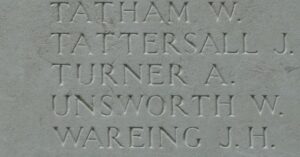
William Price, Lance Corporal, 44434, Somerset Light Infantry. William was the son of Evan and Eleanor Price, of Rhewlace, Llanfaredd. He worked on the family farm prior to marrying Sarah Jerman, of Llanidloes in 1916. He enlisted at Builth Wells into the 5th Battalion, King’s Shropshire Light Infantry. William then appears to have been transferred to the 6th KSLI, before being posted to the 1st Battalion, Somerset Light Infantry. The battalion was attached to 11 Brigade, 4th Division and had taken part in the Third Battle of Ypres before being moved to the Arras sector over the winter. On 21 March 1918 the Germans launched their offensive from the Hindenburg Line between Arras and the River Somme and, with the front line being broken, the 4th Division was moved forwards, meeting the Germans in front of Fampoux on 28 March. Heavy fighting followed over the coming days, resulting in Sir Douglas Haig noting in his despatches: ‘I doubt if any Division has killed more Germans than the 4th…’ The 4th Division was relieved from the Arras sector on 12 April and moved to Lillers, to aid the beleaguered troops which had been hit by the Germans second offensive, on the Lys Valley, which had been launched on 9 April. The 4th Division remained in this area over the coming months, holding the line near Les Harisoirs. On 18 June 1918 the battalion was in the midst of a spell in the lines, when William was killed, the sole casualty to the battalion that day. He was 29 years old and is buried in Lapugnoy Military Cemetery, France.